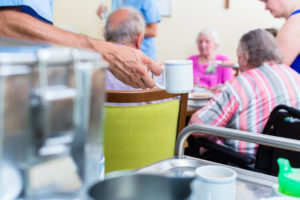Preserving identity and choice
“Supportive dining is, first, about providing healthy meals and, second, about safeguarding a sense of self,” says Antoinette Holford, a registered dietitian and StoneGate’s education and training manager. “A predictable dining experience helps residents feel in control and stay connected to who they are at the core.“We assess each resident’s stage in the dementia journey and build dining services around their individual needs.” — Antoinette Holford, StoneGate Registered Dietitian
 “We make every effort to create and maintain a familiar routine. For senior care residents living with dementia – whether in a nursing home, SNF, assisted living, or rehabilitation center – regular mealtimes provide consistency, and that’s important to their dining success. If the routine is altered, confusion can set in, affecting their mood for hours.”
Extra care is taken to make each meal flavorful and visually appealing. Heart-healthy selections use herbs and spices as primary seasonings. Nutritious, eye-pleasing pureed foods are prepared for those with swallowing challenges.
Residents in senior living communities who are living with dementia may also experience changes in depth perception. Colors, once vivid, may eventually appear as shades of grey. “We use bold, solid-colored dishware. High contrast makes it easier to distinguish food items and beverages from the containers that hold them.”
Providing ample choice is essential and the Villages on MacArthur offers a variety of meal options. Printed menus are available for those who can read. For those who no longer have the ability to read, plates of food are displayed for resident selection. Along with regular mealtimes in the dining room, room service is available at any time.
“We make every effort to create and maintain a familiar routine. For senior care residents living with dementia – whether in a nursing home, SNF, assisted living, or rehabilitation center – regular mealtimes provide consistency, and that’s important to their dining success. If the routine is altered, confusion can set in, affecting their mood for hours.”
Extra care is taken to make each meal flavorful and visually appealing. Heart-healthy selections use herbs and spices as primary seasonings. Nutritious, eye-pleasing pureed foods are prepared for those with swallowing challenges.
Residents in senior living communities who are living with dementia may also experience changes in depth perception. Colors, once vivid, may eventually appear as shades of grey. “We use bold, solid-colored dishware. High contrast makes it easier to distinguish food items and beverages from the containers that hold them.”
Providing ample choice is essential and the Villages on MacArthur offers a variety of meal options. Printed menus are available for those who can read. For those who no longer have the ability to read, plates of food are displayed for resident selection. Along with regular mealtimes in the dining room, room service is available at any time.
Personalizing the experience
Key to successful supportive dining is a person-centered approach. “We assess each resident’s stage in the dementia journey and build dining services around their individual needs,” Holford says.For example, a person with dementia may not be able to verbalize why the aroma of roast beef and gravy is comforting to them. But we can see by their response that it is. Food can be a mood changer, in the best of ways.” Families are closely involved in food decisions. Staff explore with family members their loved one’s dining history. What was their mealtime routine? What type of food do they delight in? Holford tells the story of a resident who enjoyed fast food. Day after day, his family brought him a hamburger and French fries. When the family took an extended vacation, the nutrition services manager noticed the resident stopped eating. “She asked area fast-food restaurants for some take-out containers with their logo. Each night, the staff prepared his meal and served it to him in a takeout box. His routine was restored, and his interest in eating returned!”“Food aromas, sights, and sounds evoke memories that are hidden away in the brain….Food can be a mood changer, in the best of ways”
 Promoting staff skills
Promoting staff skills
The best supportive dining service in senior care communities hinges on carefully trained frontline staff. “These are the ones who sit with residents while they eat,” Holford says. “They’re the first to observe how needs may change. They see how much a resident is eating, what they are eating, and how they are interacting with their surroundings – and can recommend new approaches to food and ambiance.”
Holford provides training updates to caregiver teams, focusing on such topics as food presentation, mealtime atmosphere, and behavior management. “It’s important for staff to observe resident behavior closely, because foods once customary can readily change as the resident’s journey takes a new turn.
Someone whose favorite nightly treat was ice cream may now respond with disinterest. Someone who used to avoid a certain food for ethnic or religious reasons – pork, for example – may suddenly be reaching for the ham and bacon. Previous boundaries have blurred.”
Providing the right environment
“We like to mimic the family table and set the stage for interaction,” Holford says. For example, a bowl of salad and a basket of bread are put on the table to pass around family style. “Sometimes it works, and sometimes it doesn’t. Something that happened four or five hours or maybe even a day earlier may affect the resident’s mood and response to meal participation, though they may not be able to define it. We strive to respond to changing behaviors with patience, flexibility, and encouragement.”Every effort is made to create a calm and relaxing experience. Diners are typically seated at tables of four to six. “They can sit wherever they like, but often choose the same seat and table. Sitting in the same place enables residents to have control,” Holford explains. “They’re in their spot, and they entirely own it. We also use square edges as opposed to round, because square lines clearly define space.” Mealtime is typically a social event. “If the resident can’t verbally participate in a conversation, just being at the table can evoke a feel-good response. The experience of being in the presence of others is stimulating in the best of ways. Our goal is not only to provide nutritious meals but also to create a sense of connection and belonging.”“Mealtime is typically a social event. Our goal is not only to provide nutritious meals but also to create a sense of connection and belonging.”
Resources:
- Senior Dining: Turning the Tables
- The Pioneer Network
- Empowerment: Taking a New Approach to Dementia — Part 1: Confronting the Challenges
- Empowerment: Taking a New Approach to Dementia — Part 2: Seeking the Solutions



